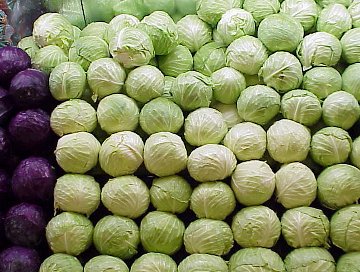Cabbage Hints and Tips
Cabbage is made up of clusters of stiff leaves in overlapping, compact layers. There are several varieties including green, purple, red, and savoy. Cabbage belongs to the Cruciferae (mustard) family and is of the genus Brassica, species oleracea, variety capitata.
TIPS:
One pound cabbage = 4 cups shredded = 2 cups cooked.
Choose firm heads that feel heavy for their size. Outer leaves should look fresh, have good color, and be free of blemishes.
A fast and easy way to remove the leaves is to cut around the core at the base. Remove the core and grasp each individual leaf at its base, rather than at the leaf’s outer edge. Gently lift the leaf from the cabbage.
To shred by hand, quarter and then core. Separate quarters into stacks so leaves will flatten when pressed lightly. Use a large knife to cut each stack of cabbage diagonally into thin shreds. To chop, turn the pile of shredded cabbage width wise, then cut shreds into a fine dice.
For a crisper cabbage for salads, shred the cabbage and soak it in salted ice water for 15 minutes and then drain.
Avoid: New cabbage with wilted or decayed outer leaves or with leaves turning decidedly yellow. Worm-eaten outer leaves often indicate that the worm injury penetrates into the head. Stored cabbage with outer leaves badly discolored, dried, or decayed probably is over-aged. Separation of the stems of leaves from the central stem at the base of the head also indicates over-age.”
Source: Photo courtesy of The Food Resource

